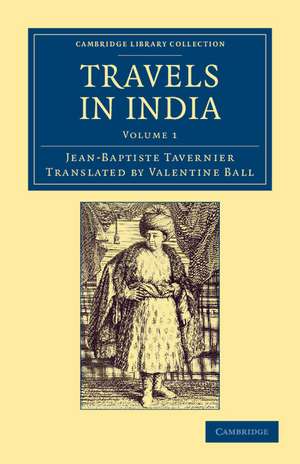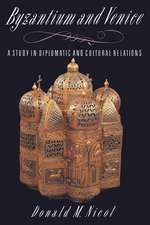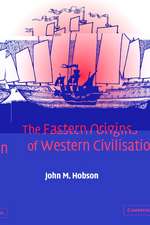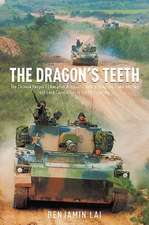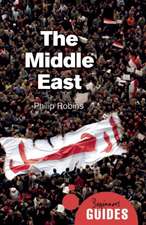Travels in India: Cambridge Library Collection - Travel and Exploration in Asia
Autor Jean-Baptiste Tavernier Traducere de Valentine Ballen Limba Engleză Paperback – 9 mai 2012
Toate formatele și edițiile
| Toate formatele și edițiile | Preț | Express |
|---|---|---|
| Paperback (2) | 473.52 lei 6-8 săpt. | |
| Cambridge University Press – 9 mai 2012 | 473.52 lei 6-8 săpt. | |
| Cambridge University Press – 9 mai 2012 | 524.55 lei 6-8 săpt. |
Din seria Cambridge Library Collection - Travel and Exploration in Asia
- 19%
 Preț: 683.99 lei
Preț: 683.99 lei - 19%
 Preț: 464.29 lei
Preț: 464.29 lei -
 Preț: 328.25 lei
Preț: 328.25 lei -
 Preț: 328.03 lei
Preț: 328.03 lei -
 Preț: 281.86 lei
Preț: 281.86 lei -
 Preț: 265.19 lei
Preț: 265.19 lei -
 Preț: 427.82 lei
Preț: 427.82 lei -
 Preț: 369.06 lei
Preț: 369.06 lei - 19%
 Preț: 457.34 lei
Preț: 457.34 lei -
 Preț: 366.57 lei
Preț: 366.57 lei -
 Preț: 330.55 lei
Preț: 330.55 lei -
 Preț: 445.11 lei
Preț: 445.11 lei -
 Preț: 519.27 lei
Preț: 519.27 lei - 19%
 Preț: 460.77 lei
Preț: 460.77 lei -
 Preț: 331.31 lei
Preț: 331.31 lei -
 Preț: 239.91 lei
Preț: 239.91 lei -
 Preț: 366.57 lei
Preț: 366.57 lei -
 Preț: 247.52 lei
Preț: 247.52 lei - 19%
 Preț: 461.21 lei
Preț: 461.21 lei -
 Preț: 376.85 lei
Preț: 376.85 lei -
 Preț: 420.82 lei
Preț: 420.82 lei -
 Preț: 369.45 lei
Preț: 369.45 lei -
 Preț: 369.24 lei
Preț: 369.24 lei -
 Preț: 371.36 lei
Preț: 371.36 lei -
 Preț: 277.67 lei
Preț: 277.67 lei -
 Preț: 369.62 lei
Preț: 369.62 lei -
 Preț: 518.89 lei
Preț: 518.89 lei -
 Preț: 421.04 lei
Preț: 421.04 lei -
 Preț: 335.42 lei
Preț: 335.42 lei -
 Preț: 369.83 lei
Preț: 369.83 lei -
 Preț: 371.74 lei
Preț: 371.74 lei -
 Preț: 377.44 lei
Preț: 377.44 lei -
 Preț: 314.23 lei
Preț: 314.23 lei -
 Preț: 368.10 lei
Preț: 368.10 lei - 19%
 Preț: 466.19 lei
Preț: 466.19 lei -
 Preț: 466.36 lei
Preț: 466.36 lei -
 Preț: 235.13 lei
Preț: 235.13 lei -
 Preț: 249.05 lei
Preț: 249.05 lei -
 Preț: 466.53 lei
Preț: 466.53 lei -
 Preț: 238.55 lei
Preț: 238.55 lei -
 Preț: 370.60 lei
Preț: 370.60 lei - 19%
 Preț: 455.13 lei
Preț: 455.13 lei
Preț: 473.52 lei
Nou
Puncte Express: 710
Preț estimativ în valută:
90.61€ • 94.60$ • 74.99£
90.61€ • 94.60$ • 74.99£
Carte tipărită la comandă
Livrare economică 05-19 aprilie
Preluare comenzi: 021 569.72.76
Specificații
ISBN-13: 9781108046022
ISBN-10: 1108046029
Pagini: 500
Ilustrații: 1 b/w illus. 1 map
Dimensiuni: 140 x 216 x 28 mm
Greutate: 0.63 kg
Editura: Cambridge University Press
Colecția Cambridge University Press
Seria Cambridge Library Collection - Travel and Exploration in Asia
Locul publicării:Cambridge, United Kingdom
ISBN-10: 1108046029
Pagini: 500
Ilustrații: 1 b/w illus. 1 map
Dimensiuni: 140 x 216 x 28 mm
Greutate: 0.63 kg
Editura: Cambridge University Press
Colecția Cambridge University Press
Seria Cambridge Library Collection - Travel and Exploration in Asia
Locul publicării:Cambridge, United Kingdom
Cuprins
Preface; Introduction - life of J. B. Tavernier; Bibliography; Title page of original edition; Dedication to the King; Design of the author; Table of the books and chapters; 'Avis' to the reader; Travels in India: Book I. Concerning Routes Which One May Take to Go from Ispahan to Agra, and from Agra to Delhi and Jahánárád, Where the Court of the Great Mogul Is at Present; as Also to the Court of the King of Golconda and to that of the King of Bijapur, and to Several Other Places in India: 1. Route from Ispahan to Agra by (way of) Gombroon (Bandar Abbás), where particular mention is made of the navigation from Hormuz to Surat; 2. Concerning the customs, the money, the exchange, the weights, and the measures of India; 3. Concerning carriages and the manner of travelling in India; 4. Route from Surat to Agra by Burhánpur and Sironj; 5. Route from Surat to Agra by Ahmadábád; 6. Route from Ispahan to Agra by Kandahár; 7. Sequence of the same route from Delhi up to Agra; 8. Route from Agra to Patna and Dacca, towns of the Province of Bengal; and the quarrel which the author had with Sháistá Khán, uncle of the King; 9. Route from Surat to Golconda; 10. Of the Kingdom of Golconda, and the wars which it has carried on during the last few years; 11. Route from Golconda to Masulipatam; 12. Route from Surat to Goa, and from Goa to Golconda by Bijapur; 13. Remarks upon the present condition of the town of Goa; 14. Concerning what the author did during his sojourn at Goa on his last journey in 1648; 15. History of Father Ephraim, Capuchin, and how he was cast into the Inquisition at Goa; 16. Route from Goa to Masulipatam by Cochin, described in the history of the capture of that town by the Dutch; 17. Route by sea from Hormuz to Masulipatam; 18. Route from Masulipatam to Gandikot, a town and fortress in the Province of Carnatic, and the author's transactions with Mir Jumla, who commanded the army of the King of Golconda; in which also there is a full description of elephants; 19. Route from Gandikot to Golconda; 20. Return from Surat to Hormuz, and how the author found himself engaged in a very rough and dangerous naval combat, from which he escaped without accident; Book II. Historical and Political Description of the Empire of the Great Mogul: 1. Account of the last wars in Hindustan, in which is set forth the present condition of the Empire and the Court of the Great Mogul; 2. Concerning the sickness and supposed death of Sháh Jahán, King of India, and the rebellion of the Princes, his sons; 3. Concerning Sháh Jahán's prison, and how he was punished by Aurangzer, his third son, for the injustice he had done to Prince Boláki his nephew, grandson of Jahángir, to whom, since he was the son of the firstborn, the Empire of the Moguls belonged; 4. Concerning the flight of Dárá Sháh to the Kingdoms of Sind and Gujarát; his second battle with Aurangzeb; his capture and death; 5. How Aurangzer seated himself upon the throne and had himself declared King; and concerning the flight of Sultan Shujá; 6. Concerning the prison of Sultan Muhammad, son of Aurangzer, and of Sultan Suliman Sheko, eldest son of Dárá Sháh; 7. Concerning the beginning of Aurangzeb's reign, and the death of Sháh Jahán, his father; 8. Concerning the preparations which are made for the festival of the Great Mogul, when he is solemnly weighed every year; of the splendour of his thrones and the magnificence of his Court; 9. Concerning other details of the Great Mogul's Court; 10. The Great Mogul orders all his jewels to be shown to the author; 11. Terms of the passport which the Nawáb Sháistá Khán sent to the author, with some letters which he wrote to him and the replies to them, in which the style of these countries manifests itself; Appendix.
Descriere
An 1889 translation of the account of his Indian travels by French merchant Jean-Baptiste Tavernier (1605–89).
